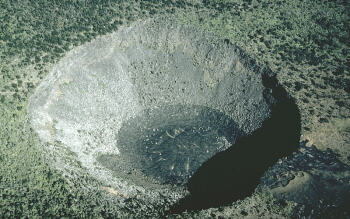
Photograph by J.D. Griggs on 5
December 1990
Aerial view of Hi`iaka pit crater on the east rift zone of Kilauea
Volcano, Hawai`i. The floor of the crater is covered by solidified lava
that poured into the crater from the lower right (note black lava flow at
crater rim).
|
Pit crater
Pit craters are circular-shaped craters formed by the sinking or collapse
of the ground. Fissures may erupt from the walls or base of a pit crater,
but pit craters are not constructional features built by eruptions
of lava or tephra. Pit craters may also partially fill with lava to form
a lava lake. They are common along rift zones of shield volcanoes;
for example, Mauna Loa and Kilauea volcanoes in Hawai`i. No one has
observed the formation of a large pit crater, but they are thought to form
as a consequence of the removal of support by withdrawal of
underlying magma.
|